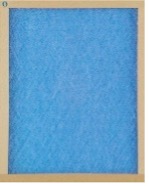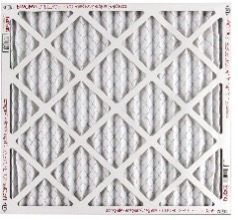Your indoor air filter is typically one of the least thought of products in your home. Trust us, we understand this. It’s housed in your HVAC system and most people don’t examine their HVAC systems regularly (more on that HERE). However, just because it is out of sight, doesn’t mean that you leave it as it is one of the most important accessories in your entire house! We also understand that the process of finding the right air filter for your home can be a cumbersome process between trying to find the right size, the right type, and trying to decipher MERV ratings vs FPR ratings vs MPR ratings. We will help simplify all of this for you and arm you with the tools you need to make the right decisions.
What is an Indoor Air Filter and why do you need it?
The air filter in your home will be constructed of a porous material, typically either spun fiberglass or some type of pleated material often referred to as a media. Also, it will typically be enclosed in a cardboard frame. There are exceptions to both of these, but for the purposes of this paragraph, we will stick with these 2 only, but we will touch on the others. After all, we told you this was the only guide you would need right? Here are examples of both a fiberglass air filter (left) and pleated paper air filter (right).


The reason that this is so important to you and your family is that this piece helps filter the air in your home of airborne particulates and contaminants. Some examples are:
- Dust
- Pollen
- Mold Spores
- Pet Dander
- VOCs
- Virus Carrying Particles
While these are examples of what filters can catch, not all filters will guard against all of these. The type of filter media and the rating of the filter will play a big factor in which of these contaminants an air filter will protect against because not all air filters are designed the same.
Fiberglass Air Filter vs Pleated Filter Media
The first decision you will have to make in choosing an air filter, will be to determine the type of filter media you will want to go with. We will start with the fiberglass filters first:
Fiberglass Air Filters
Fiberglass air filters have been around the longest in terms indoor air filters. Fiberglass air filters are the most basic form of air filter that you can purchase. Fiberglass filters are the most porous filters which helps keep your HVAC system running most efficiently and allowing for the maximum amount of airflow from an air filter. Fiberglass filters are also the least expensive type of air filter that you can purchase. Most fiberglass air filters can be purchased for only a few dollars. The trade-off to this is that they don’t offer much in terms of actual air filtration. Due to the extremely porous nature of spun fiberglass, these filters can only catch the largest or airborne particles such as dust, while leaving your indoor air vulnerable to smaller particles such as dust mite debris, pollen, and pet dander. Also, fiberglass filters must be replaced much more frequently. It is recommended to replace fiberglass air filters every 30 days.
Pleated Air Filters
The most prominently sought-after type of air filter in the market is pleated air filters. The pleated design of the air filter increases the usable surface area of the filter. Pleated air filters are not as porous as spun fiberglass filters are, so they do restrict air flow from your HVAC system, but only slightly. Since the material is less porous, it is able to capture both larger and smaller airborne pollutants and contaminants. This provides better protection for your home and will increase your indoor air quality. Also, some of the pleated filters can also absorb odors in the air. On top of having better air filtration capabilities, pleated air filters also have a longer lifespan. The typical lifespan of a pleated air filter is 90 days which helps to offset the additional initial cost of the filter compared to fiberglass filters.
BONUS – Additional Filter Types
We told you earlier that there were some newer additions to the air filter market. Well, here they are:
Poly Fiber Air Filters
Poly fiber air filters bear a strong visual resemblance to fiberglass air filters. However, they offer a great middle point between fiberglass and pleated air filters. The poly fiber media in these filters is designed to filter out more dust and dirt than fiberglass filters, but still offer better airflow and efficiency for your HVAC system. They also have a 60-day lifespan compared to the typical 30-day lifespan of fiberglass filters. While they still won’t capture smaller particles, these filters do make a great upgrade over standard fiberglass filters for budget conscious shoppers.
Washable Air Filters
Another type of air filter on the market is the washable/re-usable air filters. These filters are often constructed with a plastic casing and a synthetic filter media. The media is designed to be taken out of the casing and washed monthly and then re-used. You will typically find media replacement options that should be purchased incrementally based on the lifespan of the media. Most of these filter medias last upwards of 1 year with regular cleanings. While these filters are the most eco-friendly in terms of waste, they are typically do not provide the air filtration capabilities of the higher end pleated air filters.
Now That You Understand Filter Types, Let’s Look at Filter Ratings
As if you didn’t have enough research to do in trying to determine the type of filter that you feel is best for you and your family, they have to throw in a ratings system as well to differentiate them all. On top of that, there are multiple rating systems! We will make sense of all 3 rating systems for you.
MERV Ratings
MERV is an acronym for Minimum Efficiency Reporting Value. The MERV rating scale was developed by the American Society of Heating, Refrigerating, and Air Conditioning Engineers (ASHRAE) to measure the overall performance of an air filter. MERV ratings are assigned to filters based on their ability to capture a variety of airborne particles. These airborne particles range from large micron particles (ex. Pollen, dust, mold spores) down to smaller sub-micron particles (ex. Smog, tobacco smoke, dust mite debris). The MERV rating is assigned to a filter only after it has been tested to the ASHRAE test standard. The ASHRAE standard test is designed to measure the effectiveness of the air filter at capturing and removing a specific range and amounts of contaminants in the air. From a consumer point of view, MERV ratings are very easy to understand. The higher the MERV rating, the better the filter in terms of level of filtration. Currently, ASHRAE test standards and the MERV rating scale are the accepted industry standard for rating an air filters performance. For reference, we have included a chart to show the filter capabilities of air filters ranging from a MERV 1 to MERV 16.

FPR Ratings
The Filter Performance Rating System (FPR) is a proprietary rating system that was created by The Home Depot to measure the ability of an air filter to capture large particles, small particles, and the amount of weight gained caused by the filtration process over the life of the filter, or more simply put – weight gain. This rating system is only used on air filters that are carried by The Home Depot, whereas the MERV scale is used on all air filters. Just like with MERV ratings, the higher the FPR rating, the better the filter. However, there are 2 important factors to keep in mind:
1. The FPR rating system and tests are not industry standard, only MERV ratings and tests are.
2. FPR ratings and MERV ratings do not match. The FPR scale ranges from 1 to 10, while the MERV scale ranges from 1 to 20.
MPR Ratings
Micro-particle Performance Rating (MPR) is a proprietary air filter rating scale developed by The 3M Company to rate the performance of air filters. Similar to the FPR rating system you read about previously, the MPR rating system and tests are not an accepted industry standard. Compared to the MERV testing and FPR testing standard, the MPR tests place emphasis on the filters ability to capture smaller particles as opposed to the more common larger particles.
Now the Most Challenging Part – Determining the Right Size
Now that you know what kind of filter media you need and how to select the best filter based on ratings, it's now time to simplify one of the most daunting tasks in the shopping process – determining the right size. The main reason this is so daunting to determine is that the 2 different types of sizes are used. Manufactures put nominal sizes on the packaging. These are rounded, whole numbers which will differ from the actual size of the filter which is the actual dimension of the filter down the decimal. Don’t fret though as this is easy to figure out. If you don’t know what size filter to get, start by measure the length, width, and depth of your current filter. As an example, you may end up with 19.5” x 24.5” x .75”. Now, just take each of these numbers and round up to the nearest whole number to find the nominal size you will need to look for. In this case, it would be 20” x 25” x 1. And that’s it! We told you even though it looked daunting that it was super easy.
Conclusion
We know we have given you a ton information here on air filters and how to select the most appropriate one for your needs. We hope this helps, and check out how changing your air filter regularly can provide benefits to you beyond just air filtration